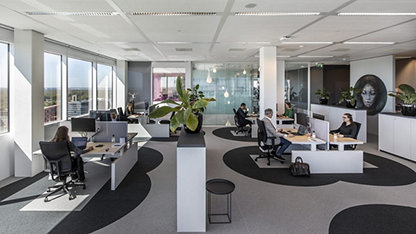This summer, Leesman undertook a comprehensive analysis of its workplace experience data. The primary objective was to gain a better understanding of the complex web of factors that impact, shape and ultimately determine the employee experience. Jo Sutherland reports from the think tank’s Manchester Insights briefing.
Leesman exists to arm facility and real estate managers with the data they need to understand what is and what is not working from an employee perspective. Its latest research report, The Workplace Experience Revolution, is based on a sample of 401,362 employee responses, and the firm’s latest worldwide event series revealed a sequence of business-critical factors on which employee sentiment hinges.
But why is employee sentiment important? Tim Oldman, Leesman CEO, suggests it is important because expectations have changed. If businesses fail to meet these expectations, they will not attract or retain talent, nor will they be able to unleash the potential of the workforce.
“As consumers, we embark on immersive, participatory and experiential journeys with brands. We expect products and services that wrap around our needs, that adapt according to our daily lives, that address and fix our pain points, and that make us feel good.”
We are in a period of change. But it is the pace of change that’s truly transforming our world, argues Oldman. It is changing the way we think, feel and behave. Successful brands like Apple, Strava, Sonos and WeWork are tapping into the fact we are living in an ‘experience economy’. These hyper-growth brands all offer immersive, participatory experiences, and they are constantly reinventing themselves in order to please us.
As consumers, we are getting used to this special treatment. We embark on immersive, participatory and experiential journeys with the brands we interact with every day, from our morning barista Fairtrade coffee experience to our evening interactions with our personalised home assistants. We expect products and services that wrap around our needs, that adapt according to the way we go about our daily lives, that address and fix our pain points, and that make us feel good.
Employees are starting to judge internal service levels based on what they can get externally. Leesman’s report examines the business-to-consumer societal shift that has reset the employer-to-employee relationship. It has uncovered a series of patterns and correlations in the data that reveal the areas that can make or break the employee experience. Get one of these elements right and there is a strong likelihood that an employee’s experience of their workplace will be positive. Get one of these elements wrong and an employee’s experience of their workplace will be negative, regardless of which other areas are done well.
Leesman analysis reveals that the strongest driver of employee experience are the things that aid ‘individual focused work’ – so quiet areas where people can get their head down and concentrate. While our sense of personal productivity is principally governed by our ability to concentrate, employees also rate ‘learning from others’ and ‘accessibility of colleagues’ as being particularly important. From this we can deduce that organisations must provide both concentrative and collaborative areas if they are to enable and empower workers that have more complex activity profiles. Interestingly, the findings show that ‘personalisation of space’ impacts employees’ ability to work, too. This gives evidence to the notion that people work more productively in spaces in which they feel comfortable and ‘at home’.
The data also offers a clue when it comes to promoting a positive corporate image and instilling a sense of pride. Top of the list in this pursuit is ‘general décor’, which suggests an employee’s perception of their company will be influenced by the physical manifestation of that image. A workplace’s ability to comfortably ‘host visitors, clients or customers’ is rated as being particularly important in this regard, too, as is the provision of ‘tea, coffee and other refreshments’. This points to the importance employees attach to being able to offer co-workers and visitors a shared high-quality experience. It also reiterates Oldman’s key observation that employees see themselves as being part of an ‘experience economy’, after those participatory, personalised moments, at work and at home.












